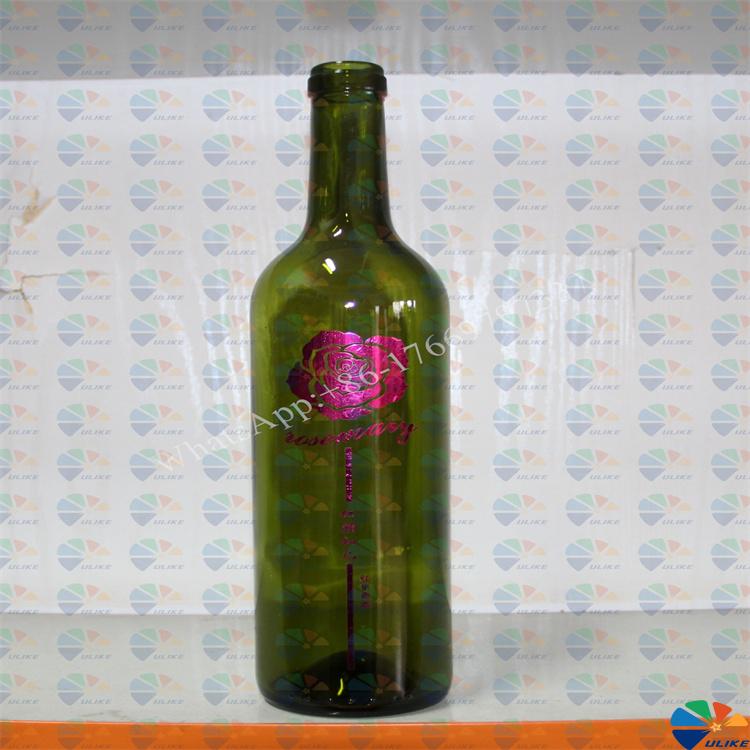Glass thermal transfer film
Glass thermal transfer film
1 Glass
thermal transfer film
Glass thermal transfer film is a type of thermal transfer film, and it is also the most expensive series of thermal transfer films. It is suitable for various regular-shaped glass products, such as glass cups, flat tempered glass products, various glass panels, etc.
With the continuous development of thermal transfer technology and the gradual popularization of glass thermal transfer technology, glass thermal transfer film is moving from the original unpopular series to the conventional series. This is undoubtedly a blessing for many glass industries, because glass thermal transfer film can make up for many shortcomings of ordinary printing technology to a certain extent. The surface decorative pattern of glass products is no longer a simple line or color block, but becomes a rich pattern with bright colors, which greatly improves the surface decorative effect of glass products. At the same time, it also greatly increases the added value of the product, and writes a new chapter for the surface decoration of glass products.
2 Glass thermal transfer film process
The production process of glass thermal transfer film is the same as that of general thermal transfer film, and it also needs to go through the following 6 processes:
1. First, apply a blank base film according to the process of the thermal transfer film to be made (release agent coating process);
2. Print the
flower film pattern (printing process);
3. Apply the corresponding glue to the printed thermal transfer film (glue coating process);
4. Re-inspect the thermal transfer film coated with glue (re-inspection process) to ensure quality;
5. Slit the re-inspected thermal transfer film into strips (stripping process);
6. Package the stripped thermal transfer film (packaging process).
3
Glass thermal transfer film characteristics
Although the production process is the same as that of general thermal transfer film, there are still some differences between glass thermal transfer film and general thermal transfer film.
For example, in the design of artwork, due to the transparent nature of glass, when designing the transfer artwork of glass thermal transfer film, attention should be paid to the pattern of light-colored dots or color blocks. A white background should be designed to prevent the pattern from being transparent, and the artwork design should be mainly based on the dot design to avoid affecting the adhesion of the pattern due to the thick printing ink layer.
In addition, when using glass thermal transfer film for the transfer process, it should also be noted whether the circumference of the rubber wheel on the hot stamping machine is longer than the length of the hot stamping pattern, because the thermal conductivity of glass is very good, which will absorb a lot of heat from the hot stamping rubber wheel. When the circumference of the hot stamping rubber wheel is smaller than the length of the hot stamping area, the hot stamping effect will be affected due to uneven heat supply of the rubber wheel.

![af]() Afrikaans
Afrikaans![sq]() Albanian
Albanian![am]() Amharic
Amharic![ar]() Arabic
Arabic![fr]() French
French![es]() Spanish
Spanish![ru]() Russian
Russian![de]() German
German![hy]() Armenian
Armenian![it]() Italian
Italian![ja]() Japanese
Japanese![ko]() Korean
Korean![pt]() Portuguese
Portuguese![hi]() Hindi
Hindi![az]() Azerbaijani
Azerbaijani![ro]() Romanian
Romanian![pl]() Polish
Polish![th]() Thai
Thai![el]() Greek
Greek![eu]() Basque
Basque![en]() English
English![zh-CN]() Chinese (Simplified)
Chinese (Simplified)![zh-TW]() Chinese (Traditional)
Chinese (Traditional)![be]() Belarusian
Belarusian![bn]() Bengali
Bengali![bs]() Bosnian
Bosnian![bg]() Bulgarian
Bulgarian![ca]() Catalan
Catalan![ceb]() Cebuano
Cebuano![ny]() Chichewa
Chichewa![co]() Corsican
Corsican![hr]() Croatian
Croatian![cs]() Czech
Czech![da]() Danish
Danish![nl]() Dutch
Dutch![eo]() Esperanto
Esperanto![et]() Estonian
Estonian![tl]() Filipino
Filipino![fi]() Finnish
Finnish![fy]() Frisian
Frisian![gl]() Galician
Galician![ka]() Georgian
Georgian![gu]() Gujarati
Gujarati![ht]() Haitian Creole
Haitian Creole![ha]() Hausa
Hausa![haw]() Hawaiian
Hawaiian![iw]() Hebrew
Hebrew![hmn]() Hmong
Hmong![hu]() Hungarian
Hungarian![is]() Icelandic
Icelandic![ig]() Igbo
Igbo![id]() Indonesian
Indonesian![ga]() Irish
Irish![jw]() Javanese
Javanese![kn]() Kannada
Kannada![kk]() Kazakh
Kazakh![km]() Khmer
Khmer![ku]() Kurdish (Kurmanji)
Kurdish (Kurmanji)![ky]() Kyrgyz
Kyrgyz![lo]() Lao
Lao![la]() Latin
Latin![lv]() Latvian
Latvian![lt]() Lithuanian
Lithuanian![lb]() Luxembourgish
Luxembourgish![mk]() Macedonian
Macedonian![mg]() Malagasy
Malagasy![ms]() Malay
Malay![ml]() Malayalam
Malayalam![mt]() Maltese
Maltese![mi]() Maori
Maori![mr]() Marathi
Marathi![mn]() Mongolian
Mongolian![my]() Myanmar (Burmese)
Myanmar (Burmese)![ne]() Nepali
Nepali![no]() Norwegian
Norwegian![ps]() Pashto
Pashto![fa]() Persian
Persian![pa]() Punjabi
Punjabi![sm]() Samoan
Samoan![gd]() Scottish Gaelic
Scottish Gaelic![sr]() Serbian
Serbian![st]() Sesotho
Sesotho![sn]() Shona
Shona![sd]() Sindhi
Sindhi![si]() Sinhala
Sinhala![sk]() Slovak
Slovak![sl]() Slovenian
Slovenian![so]() Somali
Somali![su]() Sudanese
Sudanese![sw]() Swahili
Swahili![sv]() Swedish
Swedish![tg]() Tajik
Tajik![ta]() Tamil
Tamil![te]() Telugu
Telugu![tr]() Turkish
Turkish![uk]() Ukrainian
Ukrainian![ur]() Urdu
Urdu![uz]() Uzbek
Uzbek![vi]() Vietnamese
Vietnamese![cy]() Welsh
Welsh![xh]() Xhosa
Xhosa![yi]() Yiddish
Yiddish![yo]() Yoruba
Yoruba![zu]() Zulu
Zulu


